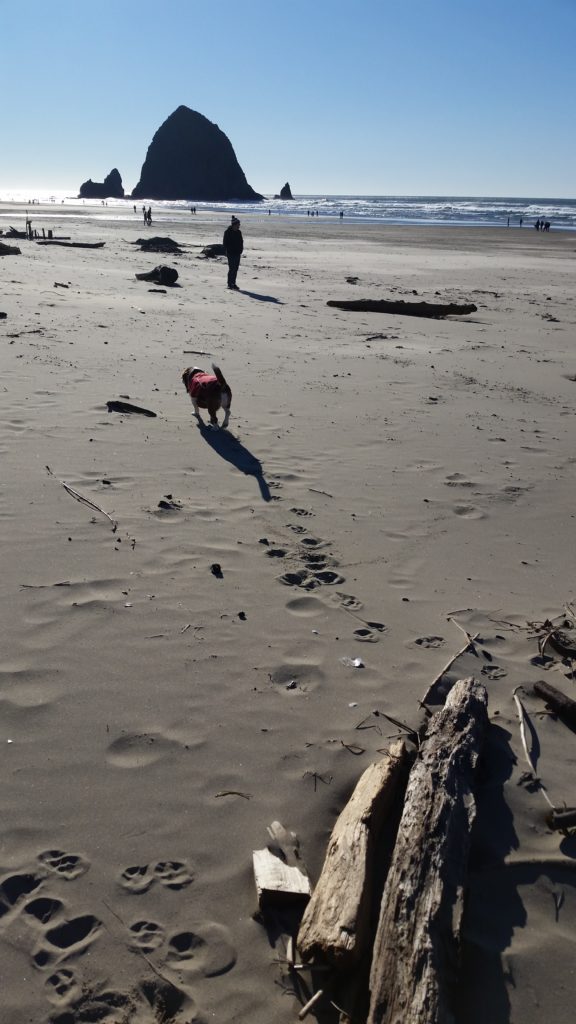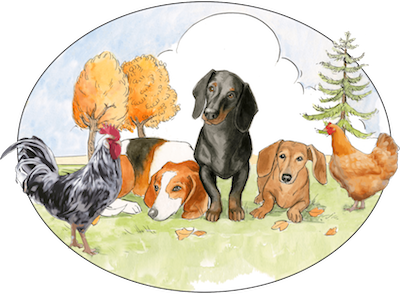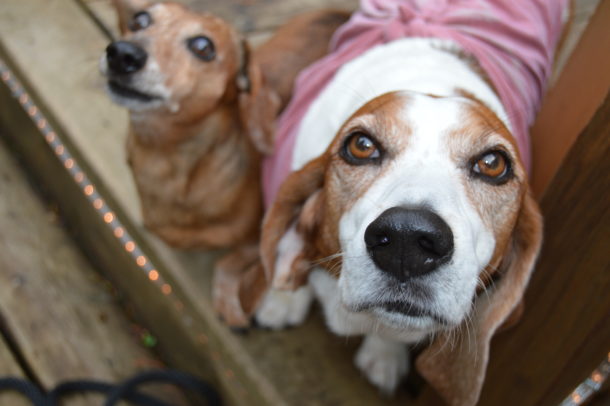Pet Poison Prevention Month: A Four Part Series
Poison Prevention Month: Protecting your pets from common household poisons
What do you do if you think your companion animal swallowed something toxic or accidentally ate something you dropped from your purse? A pill perhaps? A piece of gum? This is one of a four part series I will do on this topic. It’s SO important.
Poison Prevention Month is around the corner and I wanted to bring some light on the laundry list of food items that are dangerous for your animals. I’ve induced vomiting on more than one occasion both at home and when I was a CVT working at a clinic. Chocolate cases came in more often than you’d think – these were always scary.
Every home contains substances that are toxic for our animals including:
- Coffee grounds
- Fatty foods
- Tea
- Chocolate
- Avocados
- Alcohol
- Yeast dough
- Grapes/raisins
- Salt
- Onions
- Garlic
- Any product containing Xylitol (even certain peanut butter brands use this so read the ingredients)
There are hazards in the bathroom – medications for example. I’ve tried very hard to train my dogs to “leave it” and “drop it”. We do trade up in our household with high value treats but if it’s a small item I’m afraid my dogs would swallow it before I can run to the fridge and grab cheese.
Simple soaps and sunscreens can cause your animal to vomit. Some substances can be dangerous or even fatal if ingested so it’s really important to know when you need to rush to the emergency room.
NOTE: Inducing vomiting is NOT always the right thing to do so you need to call your vet first and ask about how best to proceed. Some items will do more harm if they are vomited so be careful!
The best advice:
“Time is critical for successfully treating accidental poisoning. Pick up the phone and call your veterinarian or the ASPCA Animal Poison Control Center (1-888-426-4435; a consultation fee may apply). Be prepared to provide your pet’s breed, age, weight and any symptoms. Keep the product container or plant sample with you to assist in identification so the appropriate treatment recommendations can be made.” –from the AVMA site
Resources:
- AVMA has a great resource for pet parents
- ASPCA Poison Control Center: www.aspca.org/apcc
- First Aid posts




Great informations, and great tips about “do” and “don’t”. Purrs
I love these lists but when it comes to garlic I put garlic powder (tiny pinch) on Laylas jerky and my friend who is a vet, and my vet says it okay 🙂
I think some dogs can tolerate certain foods ok as I also have friends that add garlic as well in tiny amounts – good reminder.
The only really bad thing Mr. N has eaten is chicken bones. He generally only believes in eating meat and cheese products.
And honestly, N is such a good dog, and so well trained I’m sure he would drop anything you told him too!
We have only had one experience – completely out of the blue. All of our dogs know leave it, stay, etc., and are very well trained. We often place a platter of food on a coffee table and the dogs have known better for 8 years….until one day, out of the blue, Mattie ate 1/2 a platter of cheeses, salami, fruit and crackers. He didn’t even get sick! Dang dog! Dogs are unpredictable, and so we learned. This is a great reminder!
Of my gosh! Sweet Mattie! I left chocolate on the counter around X-mas once and our older dog grabbed too many – we had to rush her into the vet!
You just can’t be too careful when it comes to pets and kids! Our Puggle, Theo, is forever trying to get into everything food related. He’s given me a few scares!
Same: I’ve also dropped medicine and gum on the floor by accident — Thank goodness I was also holding strip cheese.
We are super careful with any products or plants that are hazardous to the boys. We had to cut down one of my favorite trees because it is poisonous. YOu can’t be too careful. ♥
Oh my gosh! We cut down our rhododendron out back! US too!
You can never be too careful when it comes to household items and pets… foods that are perfectly okay for humans and be downright dangerous for our pets.
Agreed: And even though every dog is different, it’s important to be really careful. I didn’t know about raisins until a few years ago!
Love this post. There are just so many things our pets can get into they are just like little babies that experience the world where everything goes into there mouth. Training the “leave it” and/or “drop it” is SO important.
Have your pet’s age, weight and other important info in writing with the emergency number for the vet or the hotline. Many times if you are in panic mode your brain is not thinking clearly. Having this info in writing will actually help you relax slightly because you are able to provide the information clearly to the emergency personnel.
I is difficult to be calm when your pet’s life is on the line but it is so important.
Thanks for sharing this great info.
This is excellent advice: You’re in a panic and need to think quickly on your feet.
Very scary! Thanks for sharing the contact information – everyone should have important numbers programmed into their phones.
Totally agree: This is one of the numbers I’ve had to use in a pinch so having it available is key!
I’m looking forward to you series! Thank you as this information is so important! I called once with Harley, I was being overprotective but the person on the other end was so helpful and kind. Thankfully everything was fine & I was just being overprotective! Better safe than sorry!!
Thank you! I also have found they are SUPER helpful and walk you through the basic steps.
We have to be so careful with Kilo as he is a greedy agile thief and will not drop unless you trade. He has been to the vet on several occasions (chocolate, onion etc). I have had excellent experience with the ASPCA Poison Control Centre- such fast and helpful responses. My vet actually recommended calling them first as they have databases of lots of responses and outcomes they track so they can estimate risks based on pet breed, size, weight, age and other factors, then quantity of product ingested and timing.
My dogs are also greedy thief’s! At the clinic we also had a huge spreadsheet – based on breed and weight and when to make sure the animal is rushed in or if you could wait and see if any signs developed… that poison control line is such a great resource.
This is so important, and really I think too many people don’t think of little things like coffee grounds.
Ditto: I never think of coffee grounds!
Thanks for the list! Very helpful!
Thanks!
Great post! Once again I’m confused about garlic and now avocado. Recently, I’ve seen treats and some food add avocado and I’ve always heard, like you, that it is not good for our pets. When in doubt— stay away from it I guess!
From what I understand – it’s the pit in the Avocado that causes the damage. And a little garlic may be ok — but I say check just in case with your vet!
Have a pet poison control magnet on the fridge. I worry someone might drop human medication on the floor (and I won’t be there to see it) a lot. Worrying like that is not productive, but having a plan definitely is. Thanks for sharing the info!
Thanks! I have that magnet on the fridge too!
This is such an important topic and will help a lot of pet parents. The best way to prevent an emergency is to have things out of harm’s reach.
Totally agree: Setting them up for success is so important.
Teaching leave it is one of the most important things you can teach your dog. This is a great and very informative!
Thanks! I think so too — leave it is something we need to re-visit.
Great post. I have to be really careful with Truffle. She doesn’t like all “people food” but she does like some. She’s also terrible about eating plastic.
Thanks so much! It’s so tough to know what they’ll eat and what they’ll ignore.
Thanks so much for writing about this critical topic & for sharing these great resources!
Love & biscuits,
Dogs Luv Us and We Luv Them
Thank YOU!
This is an important message for dog parents — as well-mannered and trained as any dog can be, there’s always that freak occurrence when they decide to act out of character. When your snacking on things that have the potential to harm or kill your pet, take precautions. It’s not worth risking a life to leave your dog unattended near that bacon, onion and lettuce sandwich and a bunch of grapes. Not even for a moment. Great post, thanks!
Thank you! I know those Pearl Onions I’ll find in a dish and then have to remember to keep my plate out of reach – Thanksgiving is all about baby gates!
[…] Series – Part one […]